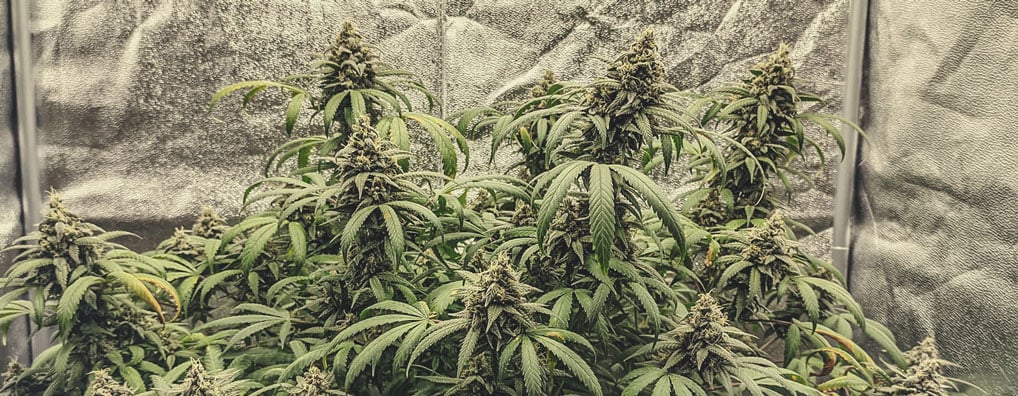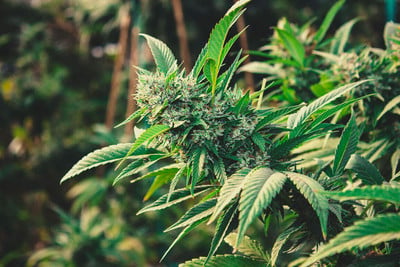.

Royal Skywalker Cannabis Strain
A mouth dryer than Tatooine. Eyes redder than Darth Maul's double-bladed lightsaber. A meditative state that'll make you feel like Yoda. These are just a few effects of firing up Royal Skywalker, so make sure you have some free time and a drink ready! This progeny of Blueberry and Mazar packs a huge THC content of 25% and offers great yields.
Contents:
Feel the force with Royal Skywalker. This potent cultivar will send you into space and cause the return of the red eye (pun intended!) after a long day of getting stuff done. The slightly indica-dominant nature of this hybrid results in dense and productive canopies. Her phytochemical profile, consisting of high levels of THC and stoning terpenes, generates a physical body high that melts the muscles while sending the mind skyward—the dank is strong in this one.
Royal Skywalker Genetics: Following in the footsteps of Skywalker OG, Blueberry and Mazar
You’ve probably heard of the famous Skywalker OG strain. Now at RQS, we’re offering our own spin on this well-known cultivar. Whereas the original leans towards the indica side of the genetic spectrum, our Royal Skywalker weed strain lands closer to the middle. In order to create this strain, our skilled breeders had to source some of the best genetics available.
They started off the process by selecting Blueberry as parent strain number one. It doesn’t take long after entering the world of weed to see this strain's name plastered all over dispensaries and coffeeshops. Just as this variety soared to fame, she served as the foundation for countless other successful hybrids and she infused them with her tasty terpenes. This A-list variety stems from parents Purple Thai and Thai. She scooped up the award for Best Indica at the High Times Cannabis Cup in 2000 and has continued to amaze cannabis users with her stoning terpenes and good levels of THC ever since.
However, our breeders didn’t want a recreation of Blueberry. They sought something different and to achieve this, they selected Mazar as the second parent. Another indica-dominant hybrid, this popular strain stems from landrace genetics in the far north of Afghanistan. Despite her indica nature, some specimens are reported to reach respectable heights when grown in optimal conditions. Mazar exerts a deeply stoning high, perfect for lazy afternoons and trippy evenings.
After crossing these two legendary cultivars, RQS breeders brought Royal Skywalker strain into the world. This variety features a genetic profile of 60% indica and 40% sativa. Her dense buds are packed with high levels of THC and fruity terpenes to boot. Now that you’re familiar with the history of Royal Skywalker, let’s take a closer look at her characteristics.
Royal Skywalker
|
|
Blueberry x Mazar |
|
|
550 - 600 gr/m2 |
|
|
80 - 130 cm |
|
|
9 - 10 weeks |
|
|
THC: 25% |
|
|
Sativa 40% Indica 60% |
|
|
500 - 600 gr/plant |
|
|
150 - 200 cm |
|
|
October |
|
|
Clear, Physically Relaxing |
Flavours, Aromas, and Effects of Royal Skywalker Strain
Blueberry. Citrus. Pepper. These are the aromas that permeate the air in grow tents, greenhouses, and gardens filled with Royal Skywalker weed plants. But this experience doesn’t only target the olfactory system. Your taste buds will also detect these notes after every bong and blunt hit. But why does Royal Skywalker produce these pleasant scents and flavours? The secret lies in her terpene profile.
As you’re possibly aware, terpenes are produced alongside cannabinoids in the trichomes of cannabis plants. These aromatic hydrocarbons unleash a whole range of aromas and flavours, depending on their combination and concentration. Royal Skywalker’s bulbous and compact flowers churn out particularly high amounts of three terpenes: myrcene, linalool, and beta-caryophyllene.
Myrcene contributes spicy, earthy, and musky aromas and flavours to Royal Skywalker’s buds. In nature, this terpene can be found in hops, lemongrass, and mangoes. But it doesn’t just make this strain taste good—it also impacts the effects it produces. Myrcene pairs up with THC to contribute to the stoning effects of the variety.
Linalool also ranks as one of the most abundant terpenes within Royal Skywalker weed. Found in basil, lavender, and roses, this monoterpene brings heavy notes of sweetness, citrus, and spice to the table. Interestingly, it acts as a cannabimimetic, meaning it mimics the effects of cannabis compounds, such as THC. In fact, linalool also binds to CB1 receptors[1]—the same sites where THC produces its psychoactive effects.
Finally, beta-caryophyllene joins the trio of terpenes that dominate in Royal Skywalker flowers. This fascinating molecule is a sesquiterpene and a dietary cannabinoid. It features in black pepper, cloves, cinnamon, and oregano. What’s more, it binds to CB2 receptors of the endocannabinoid system to produce a physical and soothing effect.
Of course, Royal Skywalker weed also contains sky-high levels of THC—the psychoactive cannabinoid clocks in at 25% in these flowers. This large quantity of THC produces a fast-acting and intense high. Beginner cannabis users need to approach this strain with caution. Even if you have a high tolerance, we still recommend going low and slow with Royal Skywalker. This quantity of THC synergises with the three terpenes mentioned above to create a deeply stoning physical effect that can sink the body into the couch. Blaze this strain during camping trips, while strolling through the forest, or while playing video games and watching movies. If you want to really push the boat out, consider using these buds to make tasty edibles and extracts with an extremely powerful punch.

Growing Royal Skywalker: Versatile, Productive Plants
Royal Skywalker grows well just about anywhere and responds well to a range of cultivation methods. Whether you like the simple and streamlined process of feeding your weed plants synthetic nutrients or the natural, but longer option of creating living soil using organic matter inputs, you’ll see great results. Because Royal Skywalker loves short summers, she offers a great option for growers living up north who have to deal with short growing seasons.
Indoors, Royal Skywalker grows to a typical height of 80–130cm. This relatively compact nature means growers can cultivate this strain in small grow tents or even converted boxes to keep things as stealthy as possible. Apply both mainlining and low-stress training to keep plants at the lower end of this spectrum. Treat Royal Skywalker to a steady supply of nutrients and powerful lights and you can receive up to 600g/m² after a flowering period of 9–10 weeks.
You can achieve these results through a variety of methods, including soil-based growing mediums and hydroponics. Some growers prefer to transplant into a rich growing medium and supplement Royal Skywalker with both veg and blooming nutrients depending on the stage of the growing cycle. Other indoor growers opt for living soil setups within four walls. Using large containers, they keep their soil thriving with the addition of dead and living mulches, worm castings, and bat guano. While highly beneficial, this approach can lead to an increased risk of pest infestations. To prevent this, harbour integrated pest management strategies such as insect screens, trap plants, and sticky traps. You can even introduce beneficial predatory insect species into your grow tent (if you don’t mind the thought of introducing them indoors!).
What about outside? Well, Royal Skywalker performs great in this setting too. Plants top out at a taller height of 200cm and form large, tree-like canopies loaded with buds. These plants are perfectly compatible with short summers and they reach harvest time by the time October rolls around. At this point, prepare to trim and dry up to 600g per plant. Again, you have plenty of options when it comes to achieving healthy and productive plants, from growing in larger containers to planting your seeds directly in the ground.
Let your climate influence your approach. Transplant seedlings into an area that receives at least eight hours of direct sunlight each day. If you live in a windy climate, transplant into a relatively sheltered spot if possible. Growers in warm climates see success when combining layers of mulch with ground covers, such as squash and pumpkin. Add drip irrigation into this strategy and your plants will be prepared to handle the harshest of heatwaves.
If you’re growing in a cooler region, plants will benefit from early sowing indoors. Transplant them into beds or containers that are housed in ventilated greenhouses or polytunnels, if possible. The use of dead mulches will provide an insulating effect both at the start and end of the season.
Royal Skywalker also responds very well to synthetic fertilisers. However, if you want to build a living soil that improves season after season, we suggest opting for a no-till approach and organic matter feeding regimen. Apply fresh compost at the start of the season and supplement with KNF inputs where necessary. Setting up a small worm farm will also supply your plants and soil with nourishing worm tea and worm castings throughout the season.
When it comes to integrated pest management, you can protect your Royal Skywalker specimens by planting them among polycultures of companion plants. Sow basil, beans, marigold, peppermint, and lavender close by to deter pests, attract beneficial insects, and fill your pantry at the end of the season.
Royal Skywalker Cannabis Strain: Prepare to Enter Hyperspace
Packing a bowl of Royal Skywalker is like taking a seat in the cockpit of the Millennium Falcon. Taking a hit is like pushing the hyperdrive button and sending the vessel into light speed. This strain doesn’t mess around. High levels of THC and a cocktail of stoning terpenes make their effect known immediately. Enjoy an intense stoning and euphoric high—just remember to pace yourself. As well as offering attractive effects, Royal Skywalker appeals to growers of all preferences. She thrives both indoors and outdoors, and responds well to a range of different methods, from organic to synthetic. This variety is a true cannabis gem and a legend in the making!
- Cannabis sativa terpenes are cannabimimetic and selectively enhance cannabinoid activity | Scientific Reports https://www.nature.com









































